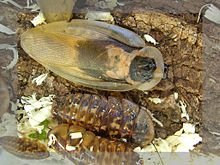 Global Information
Global InformationExopterygota information
| Exopterygota Temporal range: Carboniferous–Recent
| |
|---|---|

| |
| Death's head cockroach or brown-winged Blaberus hybrid. Adult (above) and two immatures (note wing stubs) | |
| Scientific classification | |
| Domain: | Eukaryota |
| Kingdom: | Animalia |
| Phylum: | Arthropoda |
| Class: | Insecta |
| Infraclass: | Neoptera |
| Superorder: | Exopterygota |
| Orders | |
For extinct groups and possible future splits, see text. | |
The Exopterygota (Ancient Greek ἔξω (éxō, “outside”) + πτερόν (pterón, “wing”) + Neo-Latin -ota (“having”)), also known as Hemimetabola, are a superorder of insects of the subclass Pterygota in the infraclass Neoptera, in which the young resemble adults but have externally developing wings. They undergo a modest change between immature and adult, without going through a pupal stage. The nymphs develop gradually into adults through a process of moulting.[1]
The Exopterygota are a highly diverse insect superorder, with at least 130,000 living species divided between 15 orders. They include cockroaches, termites, grasshoppers, thrips, lice and stick insects, among many other types of insects.
They are distinguished from the Endopterygota (or Holometabola) by the way in which their wings develop. Endopterygota (meaning literally "internal winged forms") develop wings inside the body and undergo an elaborate metamorphosis involving a pupal stage. Exopterygota ("external winged forms") develop wings on the outside of their bodies without going through a true pupal stage, though a few have something resembling a pupa (e.g., Aleyrodidae).
Ephemeroptera (mayflies) and Odonata (dragonflies and damselflies) also have gradual wing development, this being a plesiomorphic trait. These two orders belong to the infraclass Palaeoptera however, which is not included in Neoptera. As opposed to Neoptera, they cannot fold their wings over their back in the horizontal plane, only vertically (as damselflies do) if at all.
- ^ "Division: Exopterygota". Amateur Entomologist's Society. Retrieved 31 October 2020.